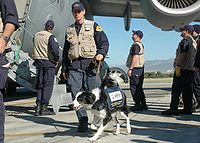- Office of Foreign Disaster Assistance
-
The Office of U.S. Foreign Disaster Assistance (OFDA) is an organizational unit within the U.S. Agency for International Development (USAID) that has delegated responsible for directing and coordinating U.S. Government relief assistance overseas. Within USAID, OFDA resides within Bureau of Democracy, Conflict, and Humanitarian Assistance (DCHA). USAID provides humanitarian assistance through mitigation and disaster response to rapid and slow onset disasters as well as complex emergencies.
Contents
USAID's Foreign Disaster Assistance Mandate
Respond to disasters and humanitarian crisis worldwide to:
- Save Lives
- Alleviate Human Suffering
- Reduce the Economic and Social Impact of Humanitarian Emergencies Worldwide
Activities
 Canine search working for (USAID) on their way to Haiti to conduct rescue operation after the 2010 Haiti earthquake.
Canine search working for (USAID) on their way to Haiti to conduct rescue operation after the 2010 Haiti earthquake.
USAID provides foreign disaster assistance to all types of natural disasters, including earthquakes, volcanic eruptions, cyclones, floods, droughts, fires, pest infestations, and disease outbreaks. USAID also responds when lives are threatened by accidental or human-caused catastrophes such as civil conflict, acts of terrorism, or industrial accidents. In addition to emergency assistance, USAID International Disaster Assistance funds mitigation activities to reduce the impact of recurrent natural disasters, as well as provide training activities to build a country's capacity for local disaster management and response.
Fiscal Year 2006 Response
In the United States of America Government's Fiscal Year (FY) 2006, which runs from October 1, 2005 through September 30, 2006, USAID responded to 74 disasters affecting more than 173 million people in 55 countries. Ongoing conflicts, drought and food insecurity, floods, a volcanic eruption, a building collapse, and health emergencies confronted countries throughout Africa. Asia and the Pacific region experienced natural disasters, including typhoons, a tsunami, torrential rains, drought, and a volcanic eruption, as well as complex emergencies. Seven countries in Europe, the Middle East, and Central Asia required assistance to address issues related to flooding, earthquakes, and complex political and security challenges. Hurricanes, heavy rainfall, and flooding led to the majority of disaster declarations in the Latin America and Caribbean region, although volcanic eruptions, localized food insecurity, and an incident of methanol poisoning also required USAID’s foreign disaster assistance.
In both natural and complex disasters, affected populations required safe drinking water, emergency shelter, health care services, food security interventions, and emergency relief supplies such as soap, kitchen sets, and blankets. Countries facing insecurity or emerging from periods of political or economic volatility also required support for local capacity building, protection of vulnerable populations, and coordination of international humanitarian response efforts.
In FY 2006, USAID provided more than $403 million to purchase and distribute emergency relief supplies and to support relief activities in the following sectors: water and sanitation, health, food security, agriculture, nutrition, shelter, capacity building, livelihoods, protection, income generation, psychosocial support, and de-mining.
USAID directed approximately 80 percent of disaster response funds to emergencies in Sudan, Lebanon, Pakistan, the Democratic Republic of the Congo (DRC), and the Horn of Africa. USAID deployed Disaster Assistance Response Teams or major assessment teams to Central America, the Horn of Africa, Indonesia, Lebanon, and Pakistan. Meanwhile, USAID foreign disaster assistance staff maintained a presence in Sudan, the DRC, and Ethiopia, and a full-time program officer deployed to monitor conditions in northern Uganda. After multiple years in Liberia and Burundi, USAID reduced foreign disaster assistance program staff and continue to transition relief programs to development activities sponsored by USAID regional bureaus.
In addition to responding to ongoing disasters, USAID directed $78 million to prepare for and mitigate the hazards of potential disasters. USAID tailored these preparedness and mitigation activities to the specific risks that communities face and designed the programs to build and improve local disaster management capabilities. In FY 2006, these efforts included support for an avian influenza stockpile, storm early warning systems, volcano monitoring programs, and improved emergency communication networks.
External links
Wikimedia Foundation. 2010.
